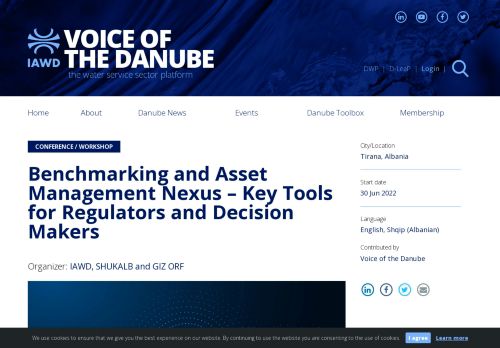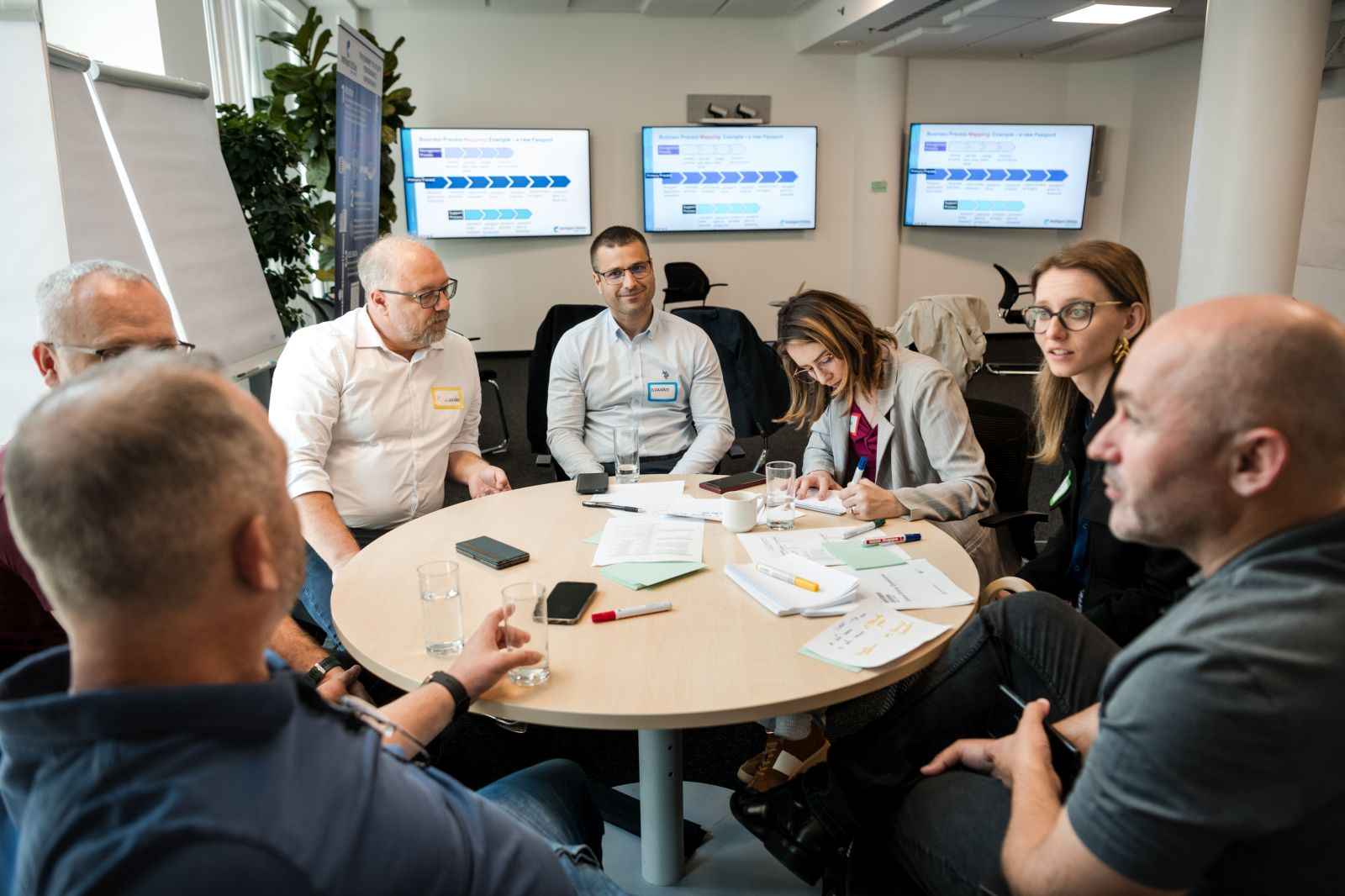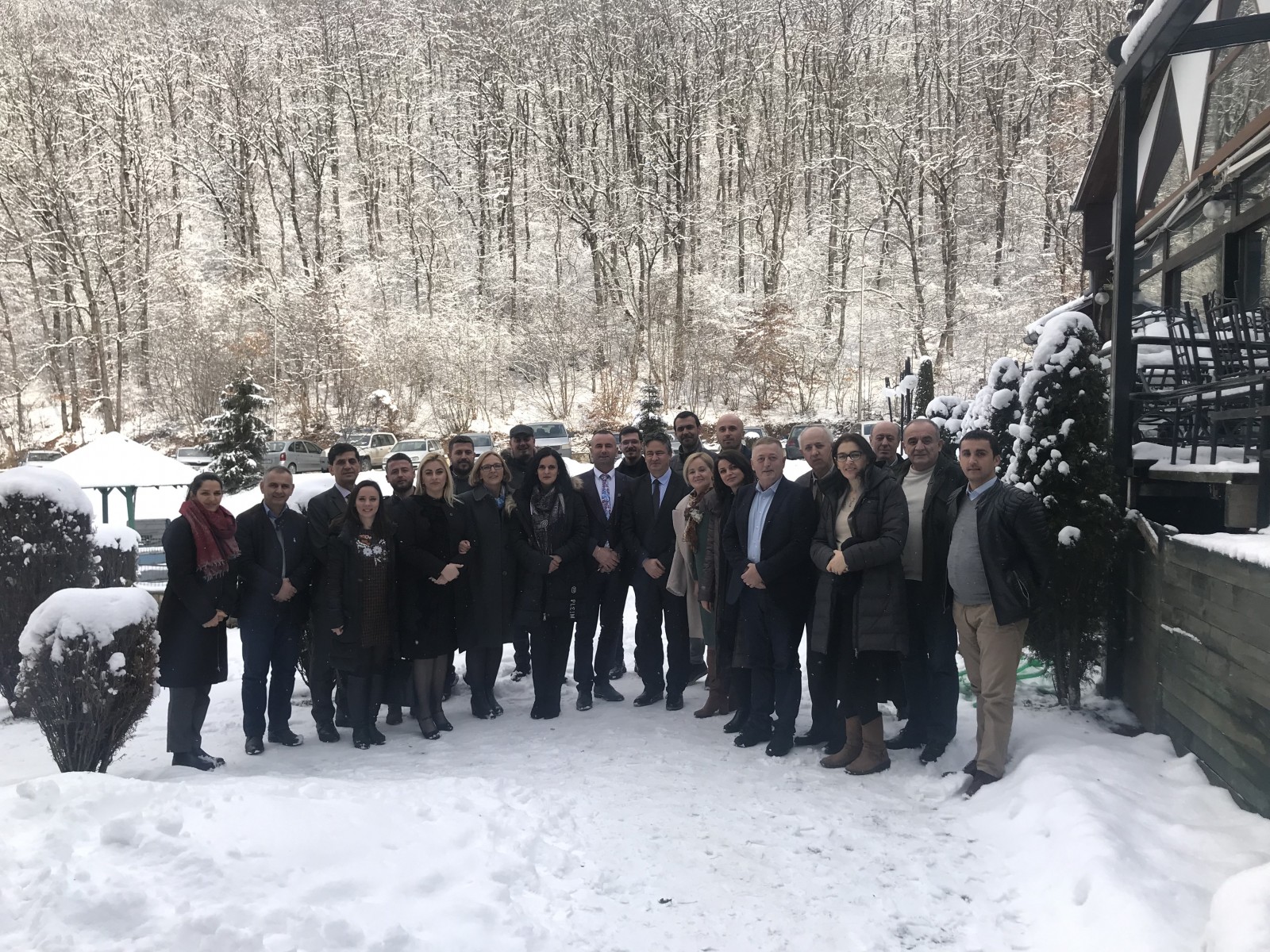
Voice of the Danube
Back to back with the 2022 Danube Water Forum, the one-day Conference “Benchmarking and Asset Management Nexus” took place on 30 June 2022 in Albania’s capital city Tirana as an invitation-only event with a limited number of seats available for all relevant stakeholders.
A joint event
The conference was organized jointly by Deutsche Gesellschaft für Internationale Zusammenarbeit (GIZ) GmbH and the International Association of Water Service Companies in the Danube River Catchment Area (IAWD) in cooperation with the Water Supply and Sewerage Association of Albania (SHUKALB) and Water and Wastewater Works Association of Kosovo (SHUKOS).
Benchmarking, Asset Management, and their importance
Strategic Asset Management (SAM) in the water sector aims at minimizing the total cost of owning and operating infrastructure capital assets while delivering a service level that meets customers' expectations. Its importance is huge and growing, with the water sector everywhere in the region facing the need for huge investments.
Sound SAM heavily relies on the availability of performance data and performance assessment routines, which are essential for (i) establishing objectives and targets, (ii) carrying out sound diagnoses that assess how far the organizations are from their targets and what are the infrastructures issues behind it; (iii) defining intervention priorities; (iv) comparing alternative solutions; and (v) monitoring the implementation of the solutions. Therefore, performance assessment and strategic asset management are complementing disciplines.
The conference aims to “nexus” the important topics of Benchmarking and Asset Management in the water service sector with the roles of national water regulators and governments on the national and local level.
The warmup
After an introduction by SHUKALB Project Manager Elisabeta Poci and welcoming addresses from IAWD President Walter Kling, GIZ Fund Manager Peter Wolf, SHUKALB President Petrit Tare, Sokol Xhafa, CEO of the Regional Water Company Prishtina and IWA Vice President Enrique Cabrera, the introductory keynote was held by Rita Salgado Brito, Chair of the Strategic Asset Management Group at the International Water Association IWA.
Stakes and stakeholders
Starting with a look at the social perception of urban water services and noting that the sector mostly operates below the radar of the public and most individual customers, and quite satisfactorily at that, Mr. Brito warned against complacency, because water systems are facing multiple challenges related to climate change, sustainable development goals, the transition to a circular economy and threatening imbalances in the water-energy-food nexus. She reminded the audience that efficient, effective and sustainable management needs to balance performance, risks and costs against the needs and expectations of stakeholders – including the next generations that will inherit the systems we have or create today. Ms. Brito walked the audience through the many ways integrated Asset Management and Benchmarking help to meet the related challenges and objectives, concluding that integrated Asset Management is about “thinking ahead, thinking across – and thinking twice”.
In the subsequent panel Maja Medenica, Head of GIS and AM Department at Belgrade Waterworks and Sewer Serbian remarked that a frequently asked question she encountered is “What is more important – Benchmarking or Asset Management?” She answers that both tools are equally important, and that Asset Management is not possible without good, reliable, frequently updated data.
Sanja Živkovi, Secretary of the Committee for Communal and Environmental Affairs at the Union of Municipalities in Montenegro, confirmed the view that these two tools are interlinked: “One does not work without the other.” She added that Asset Management cannot work without a supporting tariff policy: “If you introduce compulsory national Benchmarking, regulators will reliably start to think about a reform of the sector a few years later.”
Rita Salgado Brito finished the panel hinting at the motivational dimension of Asset Management. “Benchmarking shows companies not only how they perform, it shows that they are not alone, and that others have similar problems. She recommends to show Benchmarking results to the company staff: “Because they are the ones that move Asset Management forward”.
A close look at SEEAM
After a coffee break, the conference turned to the results and perspectives of SEEAM, the Asset Management Advisory Services to Water Utilities in South Eastern Europe program funded by the German Federal Ministry for Ecomomic Cooperation and Development and advisory company Hydro Comp and carried by GIZ, the German German Corporation for International Cooperation. GIZ Program Manager Gabriele Lames addressed the audience in a prerecorded video message, looking back on a very successful implementation phase, noting ample room for further improvement, and strongly encouraging alle stakeholders to continue with capacity development and the implementation of asset management practices to ensure a continued positive development of the water sector in the six nations participating in SEEAM.
Just the beginning
Looking at the future of SEEAM, Mr. Kolovopoulos stated clearly that even the most advanced utilities in the region would have a hard to meet the program targets within three years and encouraged the participants to keep going: “Each step is an important prerequisite for the next step, and the process is obvious: Build a registry, so you know here your assets are. This needs a lot of work, training and capacity building. Most importantly, get the knowledge out of the long-serving engineers who know the network intimately. Get it now before they retire, and put it in the computer. After that you can introduce proper maintenance procedure and recording. Without proper recording of complaints, job tickets, people, materials, pipes, cars you do not what you are doing. Only then can you forward to Stage 3, addressing your actual network, zoning, meters, distribution management.”
Collect – verify - present
The afternoon's first session treated the way “From Benchmarking to Performance Improvement and Back”, with Aleksandar Krstić, IAWD's Utility Benchmarking Program Coordinator for the Danube Region presenting an overview of the water sector performance in the Danube region.
The Utility Benchmarking Program, a foundation program of the Danube Learning Partnership, supports utilities in performance assessment and performance improvement. The program is organized in hubs to provide information exchange in local languages. Its main activities are data collection, data verification, benchmarking report delivery and information exchange in workshops and study tours. Mr. Kristic showed examples for visualizing and comparing key performance indicators in the water utility performance index and encouraged utilities not yet in the program to enter the ongoing UBP cycle, joining the national or sub-regional hubs of Albania & Kosovo, Bulgaria and Ukraine, and also the regional Danube Hub to access a crucial tool to measure, compare and improve their operational and financial performance.
Trust – not won, but hard-earned
The following panel saw Albana Jani, Director of the Department for Coordination, Analysis and Information at ACUM, Agron Haxhimali, Executive Director Association of Albanian Municipalities, Adelina Farrici, Executive Director of the Association for Local Autonomy, and Nadire Vitija, Management and Financial Expert-Trainer at Shukos, referencing the practices and perspectives of their organizations, with the main takeaways being that while it may take considerable efforts to get utilities on board at the start of benchmarking programs, and while years may pass before really trustworthy data become available from every participant, the collecting, analyzing, verifying and comparing of data is the crucial sound basis for improving everything from performance to infrastructural assets and on to dialogues with governments, regulators and other stakeholders.
Moderator Walter Kling summed up the key issue in his closing remarks, noting that the availability of data and the trust in their quality are all-important and in the end the responsibility of the utilities, but that on the other hand utilities need competent staff that can collect and deliver data in a proper form.
“In the long run, nobody will be able to get around this issue, because mayors, governments and regulators will want the data. Building trust between local authorities and utilities is essential for the water sector. I invite you to make use of the available capacity building programs under the Danube Learning Partnership.”
All about the money
The final session of the Nexus dealt with Benchmarking and Asset Management as Foundation for Sustainable Infrastructure Investment. Hosts Katerina Schilling and Elisabeta Poci led 90 minutes devoted to case studies about how these tools can be used to tap into funds.
Sokol Xhafa, Acting CEO of the Regional Water Company Prishtina, first treated the importance of Integrated Asset Management for water companies. While the identification of all assets and their registration in a data base owned and managed by utility may represent a daunting task, it is the basis of every attempt to improve efficiency.
Next on the stage was Ivana Torbica, Investment, Development and Project Engineer at the Gradiška water and wastewater utility. Her company started into benchmarking in 2014, first with the International Benchmarking Network IBNET, moving to the DANUBIS platform in 2017 and joining the Utility Benchmarking Program in 2019. As main rewards for the effort Ms. Torbica names the immediate availability, accuracy and clearness of all data relevant to the company's business activities, the opportunity to view the business from multiple angles, and the helpful exchanges and comparisons in the benchmarking network.
In 2017, Gradiška entered into asset management as well, with support from D-LeaP and NALAS. Starting from more or less zero, a partly unrecorded network, obsolete cadastral maps, no GIS or leak detection equipment and increasing problems with sewer blockages the company took a short five years to manage a complete turnaround and even won SEEAM Championship honors.
The cheapest way to improve performance
“Establishing Asset Management and Benchmarking will give you reliable data and reports, all data available in one place, better decision-making, better investment planning, better investment maintenance, better cooperation between sectors in the company, in short: improved system management and efficiency without investing significant financial resources”, said Ms. Torbica, pointing to the possibilities of modeling in comprehensive technical and financial management, including enterprise valuation models, investment planning for data improvement, maintenance, commercial recovery and loss reduction, and financial planning based on solid performance indicators, cost design and income for an extended period.
The regular updates
The two speakers were then joined by Hajrije Morina, Director of the Water Services Regulatory Authority in Kosovo and Eduart Rumani, National Programme Officer at Swiss Embassy in Albania for a compact panel that first explored what it takes to encourage utilities to use Benchmarking and Asset Management, with Sokol Xhafa summing up the answers bluntly: “If you want to cheat yourself, go without any reporting and pretend that you are working. But if you want to do something for yourself and your company, understand that it takes more than just benchmarking and asset management, we need total engagement and holistic management, and we have to update ourselves on a regular basis like we update our cellphone apps.”
Keeping the people to keep going
The panel then moved on to the necessary capacity building and human resources in general, concluding that while the programs available under D-LeaP and RCDN should also be deployed as technical assistance in investment projects, the development has reached a point where the sector should turn to employing and retaining the talent that has already been through the various programs and modules: We need proactive engagement from the utilities,” said Mr. Rumani. “Give proper incentives and show people that there is indeed a bright future in the sector.”
At this point the clock had run out. “We spent the last five months preparing this event,” said host Katerina Schilling in her farewell statement. “And it is over so fast. Thank you, Tirana, for another great event.”
To access the presentations and read the full summary, please review the link below.
VoD - Benchmarking and Asset Management Nexus – Key Tools for Regulators and Decision Makers
The Conference on “The Benchmarking and Asset Management Nexus – Key Tools for Regulators and Decision Makers” will convene on 30 June, 2022 in Albania’s capital city Tirana, back to back with the Danube Water Forum to t...



